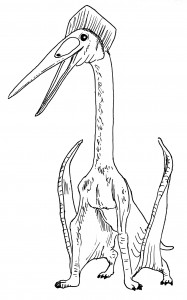Hatzegopteryx thambema – Huge Pterosaur
In two of the six episodes of the ground breaking television series “Walking with Dinosaurs”, the central characters were not dinosaurs at all. In episode three of this 1999 series, “The Cruel Sea” it was the marine reptiles that took centre stage. In a later episode, the central character was a huge flying reptile called Ornithocheirus. “Planet Dinosaur” mimics this by having segments of programmes dedicated to marine reptiles (pliosaurs), as in Predator X and to the enormous azhdarchid pterosaur Hatzegopteryx.
Hatzegopteryx
Just like its predecessor, in “Planet Dinosaur” the marine reptile sequences were featured before the pterosaur segments but for many viewers the sight of a pterosaur stalking dinosaurs like some giant, prehistoric Marabou stork is probably going to be more memorable.
And so to the Late Cretaceous and to an island archipelago in what would eventually become eastern Europe Europe (Transylvania/Romania) a place called Hateg, a place dominated by dinosaurs in miniature. Animals who find themselves cut off on an island over many, many generations often become much smaller than their mainland counterparts. As food resources are short, animals often adapt over time becoming much smaller. The smaller an organism is; the less food it requires and this might be a successful survival strategy for an animal living in a place where food is limited.
However, not all the prehistoric creatures on Hateg were small, Hatzegopteryx as a pterosaur could fly between islands and this huge creature may well have been one of the top predators in the area.
A Member of the Pterosauria
Hatzegopteryx was not a member of the Dinosauria, but a pterosaur (flying reptile), closely related to the dinosaurs but a distinct group. The fragmentary fossils indicate that this flying reptile was closely related to another giant azhdarchid pterosaur from the end of the Cretaceous – Quetzalcoatlus. Indeed, some scientists have proposed that Hatzegopteryx may well turn out to be another species of Quetzalcoatlus. Estimates for the wingspan of this creature do vary. It is only known from fragmentary remains but comparisons with other azhdarchid specimens indicate a wingspan perhaps around 12 metres plus. The skull of this giant was perhaps as much as three metres long, it being mostly comprised of a narrow, elongated, tooth-less beak.
An Illustration of Hatzegopteryx thambema
Picture credit: Everything Dinosaur
Interestingly, if you read the book that accompanies the BBC television programmes, the weight given for this flying reptile in the fact file compiled for it is and amazing 2.4 to 2.6 tonnes. This is completely wrong, although perhaps as tall as a giraffe this pterosaur weighed only about 250 kilogrammes. Ironically, in the text which is included with a close up picture of the pterosaur in the book, the weight estimate is given at around the 250 kilogramme mark.
To view replicas and models of flying reptiles such as Hatzegopteryx and other pterosaurs: Pterosaurs and Prehistoric Animal Figures (CollectA).
In the “Planet Dinosaur” sequence a group of these pterosaurs are seen stalking a herd of Magyarosaurs, one spies an infant and plucks the helpless individual from the ground with its enormous beak before swallowing it whole. This is perhaps the first time this sort of behaviour theorised for a flying reptile has been shown in such a way to a large television audience







Leave A Comment